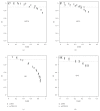Reducing false alarms of intensive care online-monitoring systems: an evaluation of two signal extraction algorithms
- PMID: 21461385
- PMCID: PMC3064994
- DOI: 10.1155/2011/143480
Reducing false alarms of intensive care online-monitoring systems: an evaluation of two signal extraction algorithms
Abstract
Online-monitoring systems in intensive care are affected by a high rate of false threshold alarms. These are caused by irrelevant noise and outliers in the measured time series data. The high false alarm rates can be lowered by separating relevant signals from noise and outliers online, in such a way that signal estimations, instead of raw measurements, are compared to the alarm limits. This paper presents a clinical validation study for two recently developed online signal filters. The filters are based on robust repeated median regression in moving windows of varying width. Validation is done offline using a large annotated reference database. The performance criteria are sensitivity and the proportion of false alarms suppressed by the signal filters.
Figures





References
-
- Chambrin MC, Calvelo-Aros D, Jaborska A, Chopin C, Ravaux P, Boniface B. Multicentric study at monitoring alarms in the adult intensive care unit (ICU): a descriptive analysis. Intensive Care Medicine. 1999;25(12):1360–1366. - PubMed
-
- Tsien CL, Fackler JC. Poor prognosis for existing monitors in the intensive care unit. Critical Care Medicine. 1997;25(4):614–619. - PubMed
-
- Lawless ST. Crying wolf: false alarms in a pediatric intensive care unit. Critical Care Medicine. 1994;22(6):981–985. - PubMed
-
- Reslan Z. Clinical alarm management and noise reduction in hospitals. University of Connecticut; 2007. M.S. thesis.
Publication types
MeSH terms
Substances
LinkOut - more resources
Full Text Sources
Other Literature Sources
Medical

